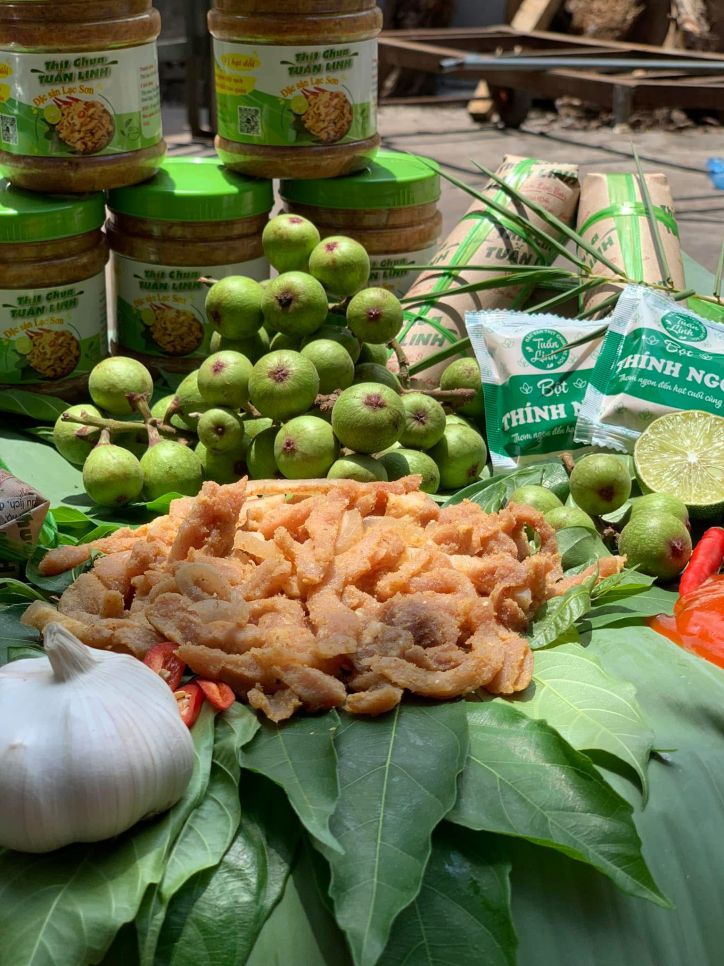With traditional cooking methods, typical ingredients and the passion of local people, this dish is gradually affirming its position on the culinary map of the highlands.
Maintaining the soul of Muong Vang cuisine
In Vu Binh commune, Lac Son district (old) now Lac Son commune, Phu Tho province, sour meat was once called "salted meat" and was a way to process and store meat for a long time. The dish is prepared by naturally fermenting, pork mixed with ear and characteristic spices such as garlic, chili, and Doi seeds. Over time, the dish has not only been used on the day of the grain gathering but has become an indispensable dish for Tet, weddings, and welcoming distinguished guests.
Since 2016, some households in Vu Binh commune, Lac Son district, Hoa Binh province (old) now Lac Son, Phu Tho province have started producing sour meat in the direction of goods. In particular, Ms. Bui Thi Tin's Lam Tin sour meat production facility, Lam Hoa 2 street is one of the first units to build a brand, complete designs and bring products to participate in the OCOP program.
"Making traditional dishes is not only for sale, but also to preserve the flavor of our hometown. While making clean and delicious products, and telling the story of the land and people - that is what I have pursued since the beginning, Ms. Tin shared.
Currently, Lam Tin facility supplies about 3,500 sour meat products to the market each month, including two main types: Sour meat and sour meat. All have standard packaging, QR stamps trace the origin, expiration date and clear instructions for use.
After being recognized as meeting 3-star OCOP standards in 2022, the product has been available at many OCOP stores in and outside the province, distributed at clean agricultural product points in Hanoi, Hai Phong, Nam Dinh...
What makes the difference of Lam Tin sour meat is the choice of ingredients and the production process. The meat is taken from clean pigs, with enough lean, fat, and skin to ensure fat. The ear is made from corn, has a high starch content, is thoroughly roasted and ground.
Doi - a typical spice of the Muong people is grilled just enough to preserve the aroma, then crushed and mixed with garlic and salt in a certain ratio. The meat is thinly sliced, seasoned and then steamed. Do not use preservatives or artificial enzymes, each batch of meat must meet the standards of temperature, moisture and natural fermentation time.

From a rural kitchen to a large market
Not only Lam Tin facility, in Lac Son commune, Phu Tho province, there are currently nearly 10 households producing sour meat. Some households such as Tuan Linh sour meat production facility, Lam Hoa 1 street are also boosting production and consumption.
Starting operations since 2022, Tuan Linh facility produces about 1,000 products per day, distributing in provinces such as Hanoi, Phu Tho, Quang Ninh... Thanks to social networking applications such as Facebook, Zalo in marketing, the product reaches more customer groups.
Ms. Nguyen Thuy Linh, owner of Tuan Linh sour meat production facility, shared: I inherited the experience passed down by my grandparents and parents, and tried my best to find a standard formula to develop my family's own brand - Tuan Linh sour meat brand. Currently, the facility is supplying the market with 2 types of products: sour meat and fruit priced at 35,000 VND/fruit and sour meat and canned meat priced at 70,000 VND/box".
Ms. Lo Thi Khuyen (Dien Bien), a long-time customer, said: "I have tried many types of sour meat, but am impressed with Lam Tin and Tuan Linh sour meat because of its light sour taste, richness, and the aroma of Doi seeds. Every time I miss this dish, I ask a friend to come over and buy it and then send a bus to Dien Bien.
According to Mr. Bui Van Khanh, Chairman of Lac Son Commune People's Committee: Sour meat is one of the typical products of the locality. In recent years, the commune government has actively supported people in promoting, packaging, food hygiene and safety and connecting markets. In the coming time, the commune will continue to support and encourage establishments to expand production and improve product quality.
From the small kitchen of Muong Vang people, sour meat has gone a long way to become a dish with a brand, market and a foothold in the hearts of consumers. This is not only the result of economic acumen, but also the efforts to preserve and promote the culinary culture of a long-standing community. In each piece of sour meat is the sweet taste of the land, the sweat of the workers and the soul of the countryside that has lasted over time.










